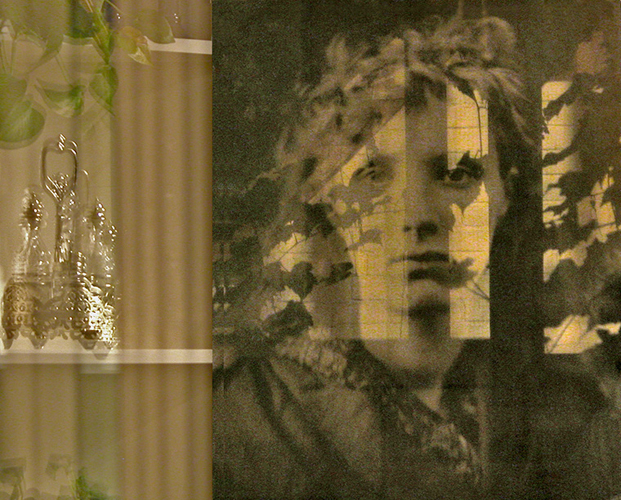MODEST SABOTAGE

At St. Michael’s Hospital in Toronto, I was hoping for a multitude of Christs on crosses, pale anemic skin, blood dripping from hands, loins diaper-wrapped, bodies hanging limply. I had plans. Christ with a delicately painted pink triangle on his loincloth, spangles in his beard, a lizard tattoo on his chest, stylish blond streaks, and ruby-red stilettos.
Soon my partner Sonja would check in for surgery. Every day she had to remain there, I would leave a mark on another Christ. Restraint was necessary since Sonja was not pleased with the whole idea. Just modest sabotage, I promised. Nothing so flashy as defacement. Only tiny transformations that wouldn’t catch anyone’s attention until we were long gone.
“Remember, sweet Kate,” Sonja said with a familiar flourish of her hand, “it’s my life on the line. I don’t want to offend anyone. In fact, I want to make friends with the nurses.” Flirt, I thought!
I was a bit disappointed that she wasn’t bolder. “Seize the opportunity,” I insisted. “Carpe diem. Remind that damn hospital that it belongs to the whole community and should keep its self-righteous politics to itself.” These days, my blood was boiling with the almost daily barrage of anti-abortion rhetoric, resurfacing in these dark times like slime from the bottom of an abandoned sewer. Anything to do with religion reeked of self-serving sanctimony.
When I had been sick in that same Catholic hospital a few years before, Christ on the cross was the first thing I saw when I opened my eyes. An orderly leaked the secret: I could ask the nurse to take it down. Before she agreed, reluctantly I might add, she told me that the Crucifix helps us to adore Christ, inspires us to bear suffering patiently, and is the model of true love. No kidding!
Well, the best laid plans. When Sonja and I arrived at the hospital and settled in her room, there were no crucifixes to touch up.
Sonja was sent for tests. “No, you can’t come,” the orderly said to me. “No, she doesn’t need company.” How would he know? I didn’t like his tone and wanted to kick him. I could hear Sonja’s soft voice: “Temper. Temper.”
I sat on the window sill after he wheeled her out. The room was eerily empty. Only a clock ticked, a sound I despised.
To distract myself from the chorus of unspeakable medical imaginings, I went on a discovery walk. I took the elevator down to the ground floor and wandered. A statue of St. Michael the Archangel filled the hospital lobby with its formidable presence. Supposedly it’s a symbol of hope but the battle armour and hefty sword told another story. On its chest, I noticed four small triangles, aka the Cross of Amalfi, which were definitely in need of a pink touch up.
A plaque near the bottom offered the checkered history of the statue. The Sisters of St. Joseph found it in a dirty and decrepit state on Queen Street in 1875, and bought it for forty-nine dollars, money they had accumulated from the sale of old newspapers. I imagined the nuns packaging up papers and counting their pennies, and thought, like my mother always said, that nothing is quite what it seems. Circling the statue, I noticed Pietrasanta chiseled on the back. The feel of the worn letters on the smooth stone reminded me that Michelangelo found the purest marble in that Tuscan town.
A waiting room off to one side had banks of orange seats. I picked up a magazine from a pile and perused it. The Catholic Women’s League wanted government money for student internships but refused to respect the Canadian Charter, in particular LGBTQ and reproductive rights. Such hubris! Now, in 2019!
I imagined placing an ad in that magazine. “Bring Christ into the 21st century,” it would challenge the reader. “Embrace an inclusive colour scheme.” A photograph would display a cluster of Christs: a black one and yellow one, a brown one, a pink one with stripes, and one the white of newly driven snow (a nice cliché, I’ve always thought).
Enough of Catholic transgressions! I made my way to Sonja’s room. She was back from her tests.
“Any news?” I asked.
“Surgery tomorrow morning.”
I pulled the hospital chair up against the railing and held her hand, gently smoothing her palm with my fingers. I closed my eyes. My mind was teeming with ingenious inventive imaginings. What about inviting the gay men’s choir to dress up in Christ garb and circle the nursing station at midnight singing “Amazing Grace” in four-part harmony? While the authorities were occupied (or star-struck, as the case might be), I would climb into bed with my sweetie and snuggle up against her back to keep her safe through the long night.
When I suggested the idea to Sonja, she expressed modest approval.
“Maybe,” she said with her always-endearing smile.
We idled away the hours with gin rummy, sharing jokes (although I am so joke-impaired I rarely get them), and a bit of cuddling in the narrow bed. We actually fell asleep until the nurses came by and shooed me toward the chair.
The next morning the orderlies arrived early to take her for surgery. I held her hand until we reached the elevator, our fingers intertwined like a Celtic knot. “I’ll be fine,” she whispered. She looked so small and frail.
More roaming. I walked the perimeter of the hospital building a few times and counted all the various entrances. I checked out the cafeteria but nothing appealed. I found an abandoned Globe and Mail folded up on a table and read through it, despairing of the human condition. Then I started visiting each floor. In the maternity ward, I discovered an eight-foot-high statue of the Virgin Mary, a splendiferous model for new mothers who had left offerings of now-dead flowers. A scheme for Mary came unbidden to my mind: a black leather jacket, mirrored Ray Bans, a pair of scuffed Dr. Martens, a nose ring, and a butterfly tattoo for her cheek.
I checked my watch.
Maybe Sonja would be back in her room. After navigating the Kafkaesque hospital corridors meant to confuse and defeat, I finally arrived at her door. There she was, looking pale and worn, but the surgery went fine, she said. She gripped my hand in hers, kissed my palm, closed her eyes and fell asleep. Safe and ready to come home soon.
No more imaginings, no more fantastical distractions. But I felt an unresolved tug. I found my way back to Mary in the maternity ward. I dug around in my bag and found an indelible marker. Just out of sight on the corner of her voluminous robe, I etched a tiny pink triangle.
Photo credit: Linda Briskin, https://www.lindabriskinphotography.com/
***
Linda Briskin is a writer and fine art photographer. You can find her website here.

